 The Two Micron All Sky Survey at IPAC
The Two Micron All Sky Survey at IPAC
![]()
 The Two Micron All Sky Survey at IPAC
The Two Micron All Sky Survey at IPAC
|
|
|
This is the All-Sky Data Release from the Two Micron All Sky Survey, covering 99.998% of the sky observed from both the northern 2MASS facility at Mt. Hopkins, AZ, and the southern 2MASS facility at Cerro Tololo, Chile. The release data products include 4,121,439 Atlas Images (full-fidelity, 512 × 1024 pixel2, 1"/pixel) in the three survey bands, derived from the 59,731 scans of the 8.5´ × 6° Survey Tiles, and Catalogs containing positional and photometric information for 470,992,970 Point sources and 1,647,599 Extended sources.
Users are encouraged to first familiarize themselves with the Explanatory Supplement.
The full-fidelity Atlas Images are now being served online. The full-fidelity Atlas Images carry full WCS information in their headers, as well as photometric zero points derived from the 2MASS calibration, and are suitable for direct measurements. Users are strongly encouraged to refer to sections I.6d and II.4b of the Explanatory Supplement for cautionary notes about their use and a gallery of known Anomalies in the Images.
 Access the Catalog and Image data via IRSA
Access the Catalog and Image data via IRSA |
 Bulk Download Catalog Data
Bulk Download Catalog Data |
 Obtain additional general information
Obtain additional general information |
 Order the DVD-ROM of Catalog data
Order the DVD-ROM of Catalog data(order at 2mass@ipac.caltech.edu) |
 View the Explanatory Supplement
View the Explanatory Supplement |
 Consult frequently asked questions (FAQs)
Consult frequently asked questions (FAQs) |
 Email the 2MASS Help Desk
Email the 2MASS Help Deskfor user support or more information |
 Please provide us with feedback
Please provide us with feedback(Currently, please use the Help Desk) |
Please include this acknowledgment in any published material that makes use of the 2MASS All-Sky Release data products.
Additionally, we encourage you to notify us (at 2mass@ipac.caltech.edu) as soon as possible about any refereed publications or conference proceedings (even in preprint form) that make use of these Release data products.
A DVD-ROM set containing the Data Release Catalogs (NOT images or movies) is available. If you are interested in ordering this product, please send us an email with your name, institution, and full mailing address. The DVD-ROM is intended for professional astronomers only. Quantities and availability are limited.
Compressed (gzipped) Catalog files are also available for bulk download at http://irsa.ipac.caltech.edu/2MASS/download/allsky/.
Thank you very much.
Integrated Source Flux of the 2MASS All-Sky Release
Sources in the Point Source Catalog (PSC) meet the following criteria:
The cumulative distribution of sources in the All-Sky PSC with galactic latitude is
shown in Figure 1. Differential point
source counts are shown in Figure 2
(for a 702.8 deg2 field with b>+75°;
Figure 3 shows counts for a
10°×10° area centered on
l=55°, b=0°.
In both of the latter figures, the blue line denotes J-band; green line,
H-band; and, red line, Ks-band.
At high latitude, the 2MASS PSC contains accurate detections
well below the nominal Survey completeness limits of J=15.8, H=15.1
and Ks=14.3 mag. The turnover in the source
counts in the Galactic Plane field occurs nearly 1 mag brighter,
because of the effects of confusion noise on the detection thresholds.
Additional general information about the 2MASS All-Sky Release
 7 OR
a source must be detected in three bands with a SNR
7 OR
a source must be detected in three bands with a SNR 5
5
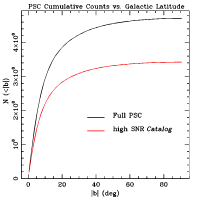
|
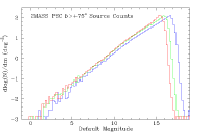
|
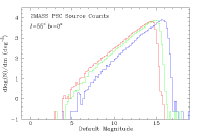 |
| Figure 1 | Figure 2 | Figure 3 |
Figure 4 shows the average quoted J, H
and Ks photometric
measurement uncertainties in 0.2 mag bins, as a function
of source magnitude, for all PSC sources having
b>75°. The vertical error bars show the RMS dispersion
in the mean uncertainties in each brightness bin, and the dashed horizontal
lines in each panel show the SNR=10 levels
(<  >=0.109 mag).
The measurement precision for bright, non-saturated sources
approaches a constant limit of 0.01-0.02 mags,
set by pixelization errors. The achieved SNR=10 levels in the
north galactic pole field are on average fainter than the
J=15.8, H=15.1 and Ks=14.3 mag specified in the
Level 1 Requirements. The brightness
estimates of the fully saturated sources are of much
poorer accuracy than non-saturated sources.
>=0.109 mag).
The measurement precision for bright, non-saturated sources
approaches a constant limit of 0.01-0.02 mags,
set by pixelization errors. The achieved SNR=10 levels in the
north galactic pole field are on average fainter than the
J=15.8, H=15.1 and Ks=14.3 mag specified in the
Level 1 Requirements. The brightness
estimates of the fully saturated sources are of much
poorer accuracy than non-saturated sources.
Figures 5 and 6 show the J-H-Ks color-color diagrams for the north Galactic cap and Galactic plane fields, with the color-coding signifying the density of sources in color bins; red represents the highest density, and blue the lowest. (The density scaling shown in each figure is relative, and specific to each sample.) The expected tracks for dwarf and giant stars from Koorneef 1983, A&A, 129, 84) and Bessell & Brett (1988, PASP, 100, 1134) are overlaid as solid and dashed lines, respectively. (The small offset between the dwarf and giant tracks and the locus of 2MASS source colors is a result of differences in the photometric system.) There is little evidence for reddening in the Galactic cap field, whereas there is considerable reddening of the stars in the Galactic plane field.
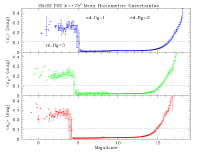
|
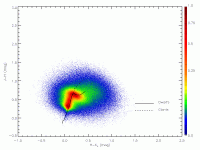
|
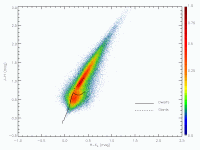 |
| Figure 4 | Figure 5 | Figure 6 |
Sources in the Extended Source Catalog (XSC) meet the following criteria:
(see the Explanatory Supplement for details on the scores).
Differential source counts (logN vs. logS) for the entire XSC is shown in Figure 7. The error bars represent sqrt(n) uncertainty measures. For comparison, deep but narrow-field counts from Glazebrook et al. (1994, MNRAS, 266, 65), denoted with a dashed line, and Gardner et al. (1997, ApJ, 480, L99), denoted with a dotted line, are shown. Figure 8 shows the J-H vs. H-Ks color-color Hess diagram for all XSC sources. For reference, we also include the stellar main-sequence and evolved (giant) tracks (green line), and the redshift K-correction (magenta line, assuming SAB-type galaxies with no evolution cosmology; adapted from the models by Bruzual & Charlot 1993, ApJ, 405, 538, and McLeod & Rieke 1995, ApJ, 454, 611).
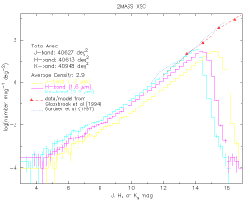
|
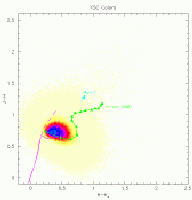
Figure 7 | Figure 8 | |
Extended sources range in size from 10´´ to nearly 2° in diameter (e.g., M31). Most 2MASS XSC galaxies are small, settling near the resolution limit of 2MASS. The distributions for extended sources of the isophotal and total radii are shown in Figure 9 (galaxies) and Figure 10 (Galactic sources).
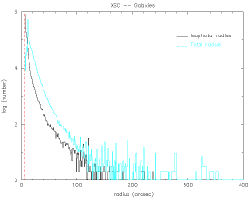
|
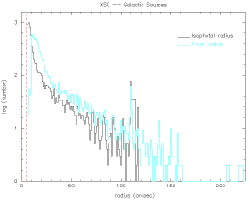 |
| Figure 9 | Figure 10 |
Please include the following in any published material that makes use of the 2MASS data products:
"This publication makes use of data products from the Two Micron All Sky Survey, which is a joint project of the University of Massachusetts and the Infrared Processing and Analysis Center/California Institute of Technology, funded by the National Aeronautics and Space Administration and the National Science Foundation."
Thank you very much.

|

|

|

|

|

|

|
| SAO |
Return to the 2MASS Home Page